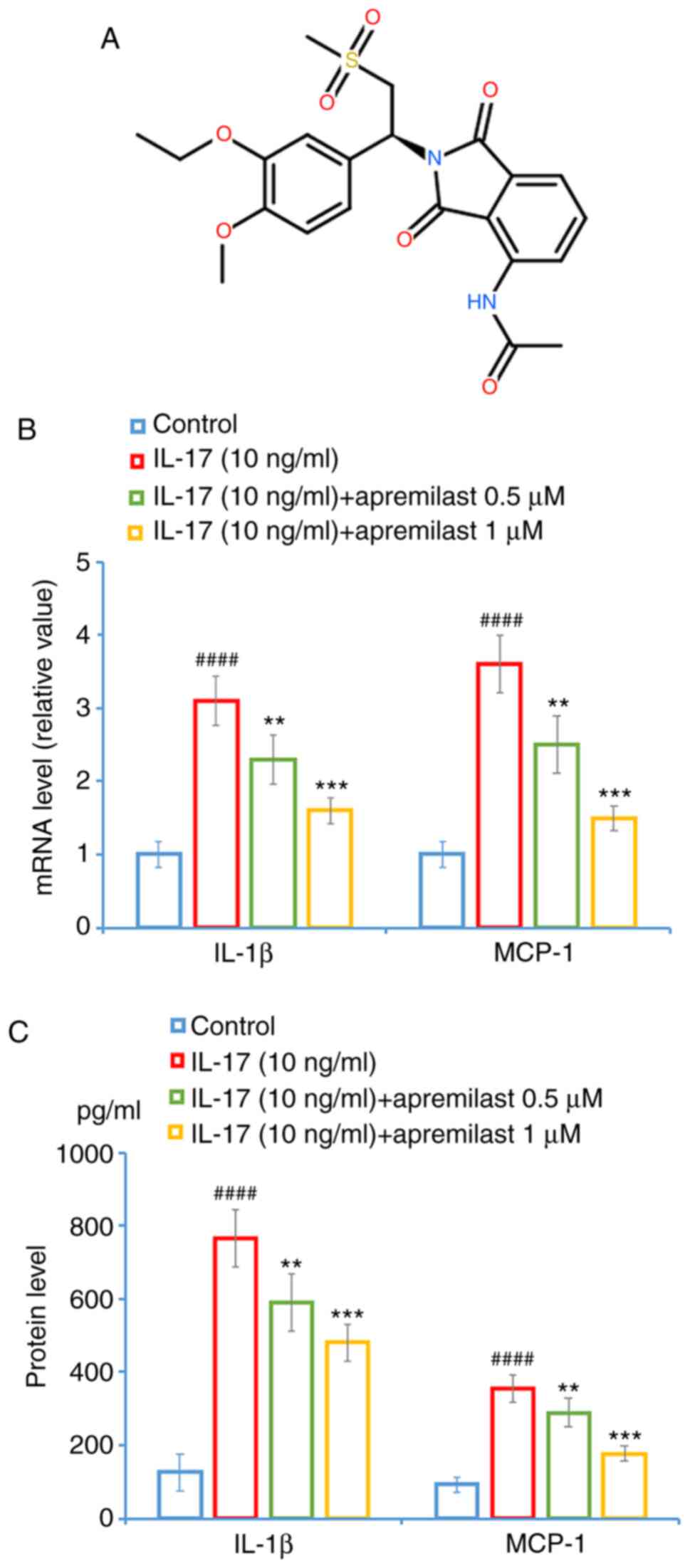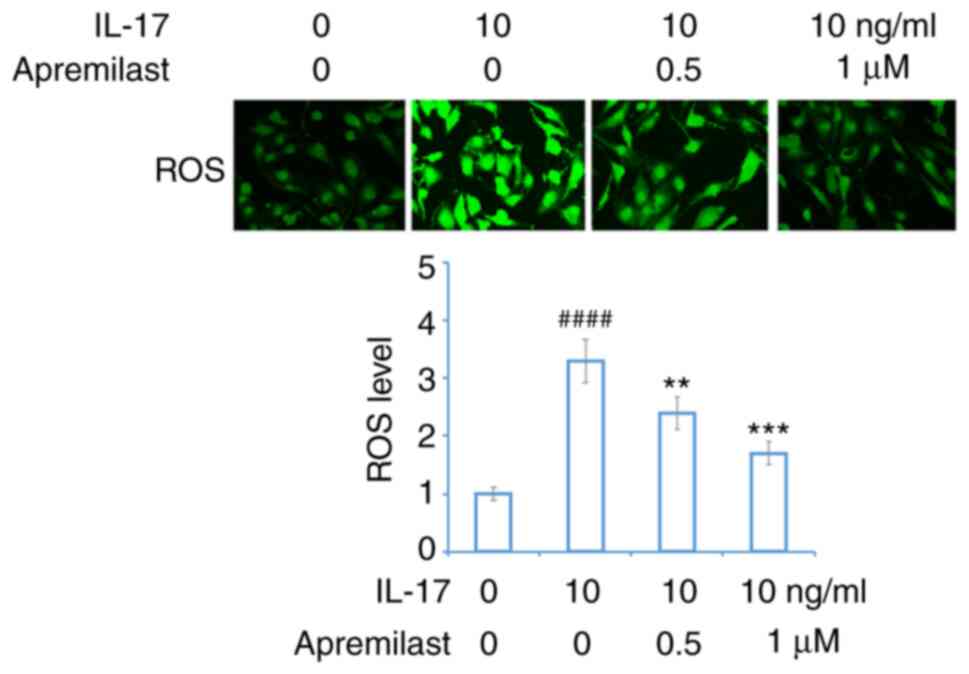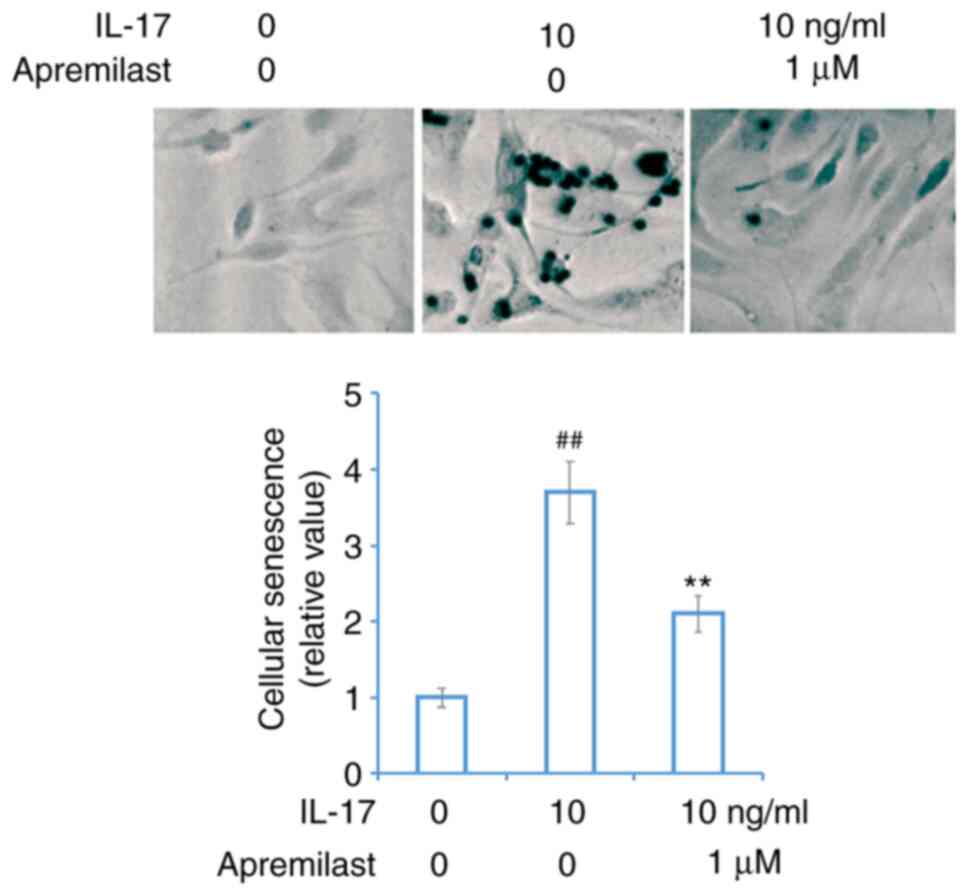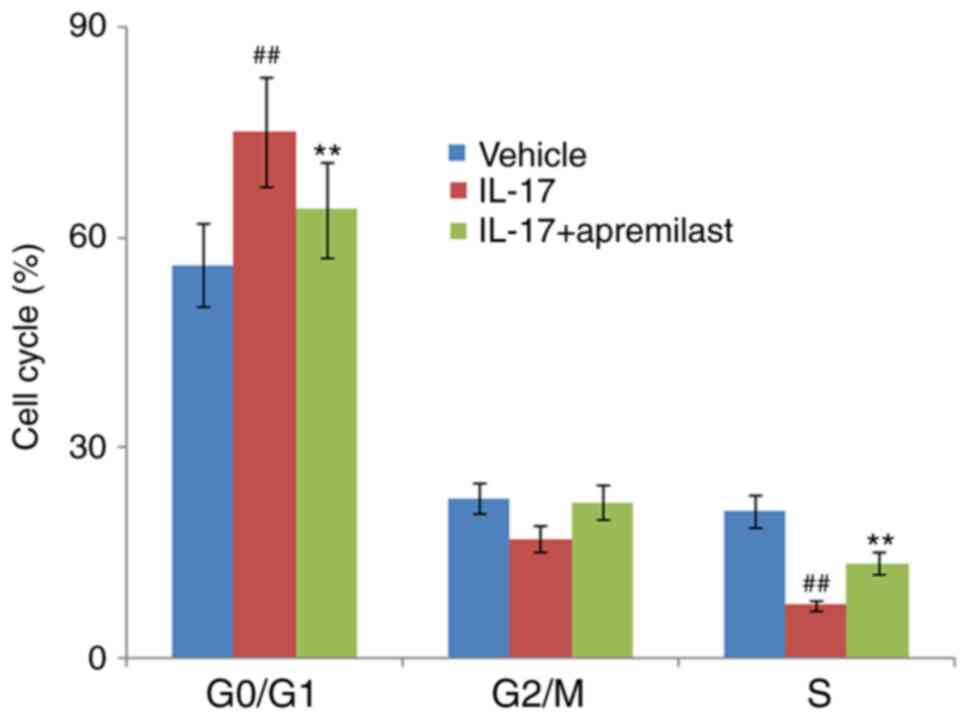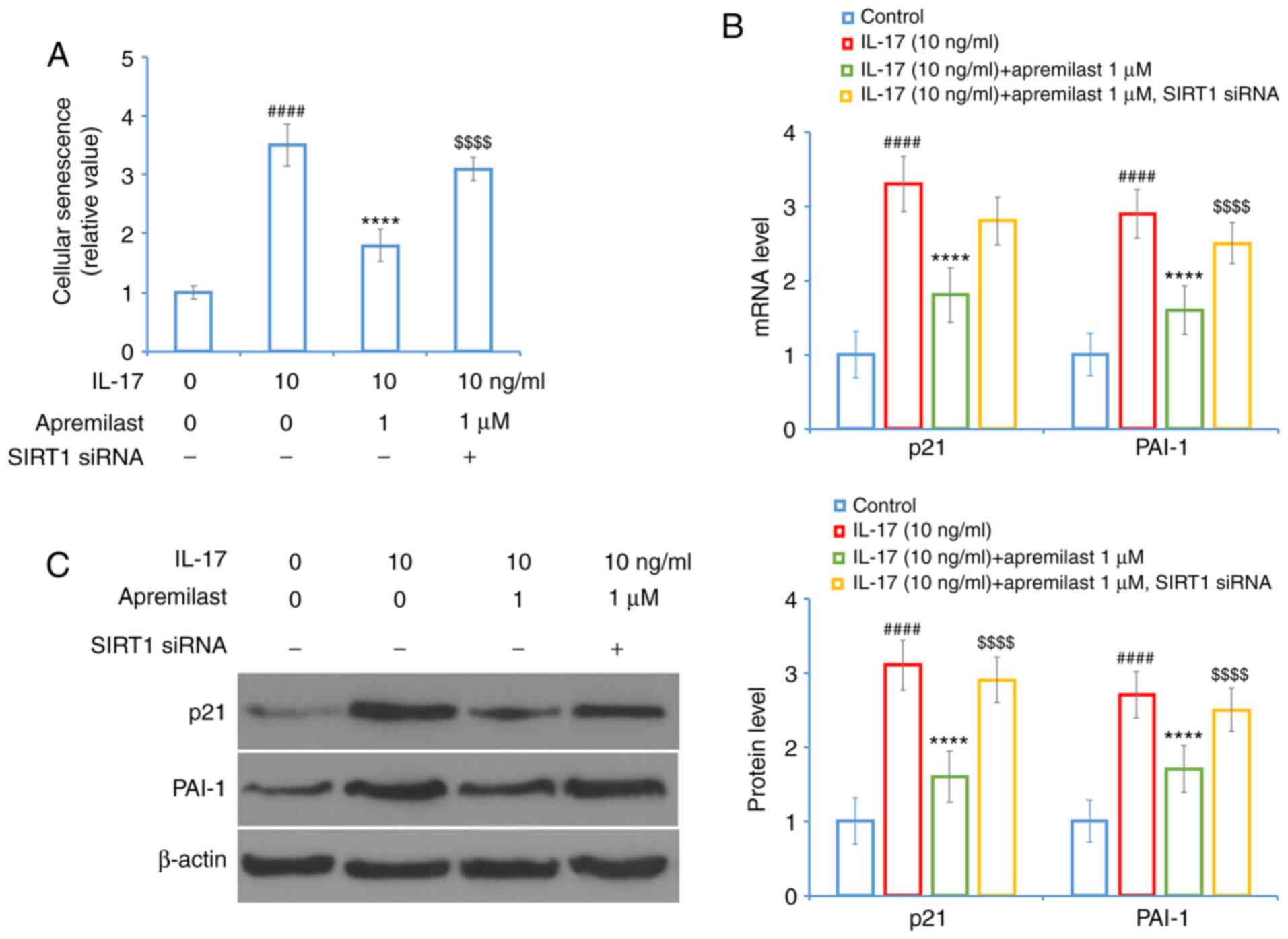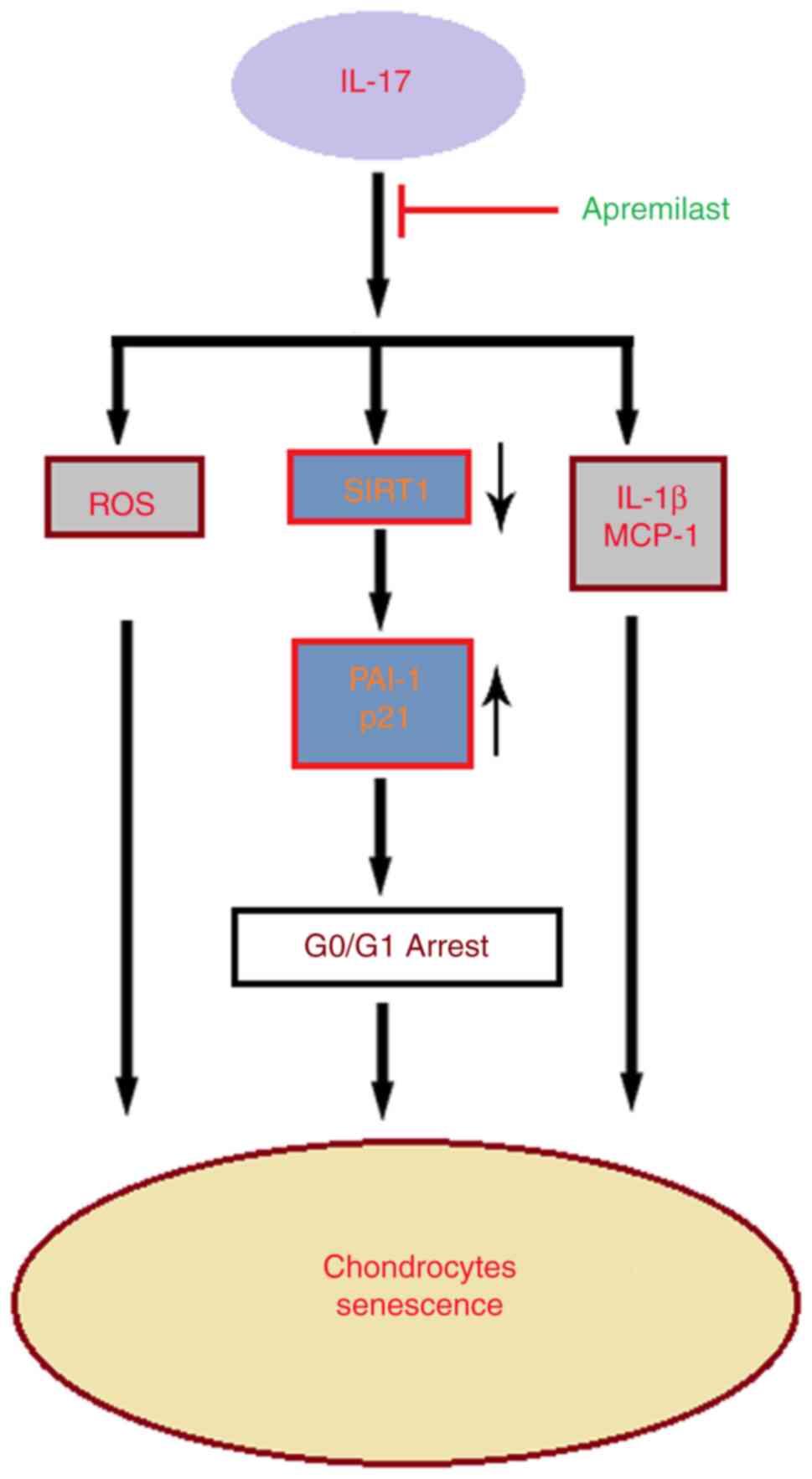Introduction
Osteoarthritis (OA), is a painful degenerative joint
disease that occurs in the elderly across the developed and
developing world and has attracted increasing attention in the past
decades (1). Although the
pathological mechanism of the disease is complicated, aging is
considered as the main risk factor in the development of OA
(2). The chondrocyte is the only
cell type found in articular cartilage. Healthy chondrocytes are
responsible for maintaining cartilage homeostasis (3). However, in the condition of OA,
chondrocytes produce various pro-inflammatory cytokines and
chemokines, which lead to chronic inflammation. Furthermore, high
levels of these cytokines result in chondrocyte senescence
(4). Cellular senescence plays an
important role in OA through G0/G1 phase cell cycle arrest and
limiting the proliferative and synthesizing capacities of
chondrocytes, resulting in disability of chondrocytes to secrete
extracellular matrix components (2). Several signaling pathways have been
implicated in the process of cellular senescence. For example,
increased expression of plasminogen activator inhibitor-1 (PAI-1)
and p21 have been considered as important biomarkers of cellular
senescence. Additionally, sirtuin 1 (SIRT1), a nicotinamide
dinucleotide (NAD+)-dependent deacylase, plays diverse
roles in negatively regulating senescence, aging, and inflammation
in different types of cells, including chondrocytes (5). The ATDC5 chondrocyte cell line.
Interleukin (IL)-17 is well known as a member of a
multifunctional cytokine family. Research has demonstrated that
IL-17 plays an important role in several inflammatory diseases,
such as psoriasis, multiple sclerosis (MS), and rheumatoid
arthritis (6). Furthermore,
studies have revealed the positive relationship between IL-17
concentration and the severity of OA (7,8).
The antibody fragment of IL-17 has been used for the treatment of
rheumatoid arthritis (9).
Although the successful application of IL-17 inhibitors in OA
patients has not been reported to date, efforts have been made by
both clinical physicians and scientific pharmacologists (10). IL-17 could induce the production
of pro-inflammatory cytokines by chondrocytes, thereby triggering a
sustained inflammatory response (11). Furthermore, IL-17 enhances the
release of matrix metalloproteinases (MMPs), which lead to joint
damage and cartilage destruction (12). However, the biological function of
IL-17 in chondrocytes remains to be elucidated.
Apremilast, an oral phosphodiesterase 4 (PDE4)
inhibitor, was approved by the US Food and Drug Administration
(FDA) in 2014 for the treatment of patients with active psoriatic
arthritis and plaque psoriasis (13). Evidence has revealed that
apremilast could inhibit PDE4 activity and blocks pro-inflammatory
cytokines such as tumor necrosis factor (TNF)-α, IL-1β, IL-17, and
IL-2 in the inflammatory response of psoriasis (14). These results indicate that
apremilast may have a protective effect on other inflammatory
diseases. Notably, the administration of apremilast revealed
efficacy in an atopic dermatitis (AD) mouse model by reducing ear
swelling and the expression of monocyte chemoattractant protein-1
(MCP-1), IL-12/IL-23p40, and IL-31 (15). Notably, apremilast has been
reported to induce an increase of the anti-inflammatory B-cell
subset Breg cells, and a decrease of Th1 cells, IFNγ-producing NKT
cells, and IL-17-producing NKT cells (16). However, it is still unknown
whether apremilast possesses any efficacy in OA.
Materials and methods
Cell culture and treatment
The ATDC5 chondrocyte cell line was obtained from
the Cell Bank of the Cell Engineering Division, RIKEN BioResource
Research Center. The cell line was maintained in DMEM/F12 medium
(cat. no. 12634010) and supplied with 10% FBS (cat. no. 10100147;
both from Gibco; Thermo Fisher Scientific, Inc.) in a 5%
CO2 humidified cell culture incubator at 37℃. For the
treatment experiment, the cells were plated in 6-well cell culture
plates and treated with IL-17 (10 ng/ml) (R&D Systems, Inc.) in
the presence or absence of apremilast (0.5 and 1 µM)
(MedChemExpress) at 37°C for 24 h.
RNA isolation and reverse
transcription-quantitative (RT-q) PCR
Total RNA was isolated from ATDC5 cells using TRIzol
(cat. no. 15596018; Thermo Fisher Scientific, Inc.) following the
manufacturer's protocol. The total RNA was treated with DNAase
(cat. no. M0303S; New England Biolabs, Inc.) and then quantified
using a Nanodrop spectrophotometer (Thermo Fisher Scientific,
Inc.). RNA (2 µg) was reversely transcribed into cDNA using
an NGS Reverse Transcription kit (cat. no. A45003; Thermo Fisher
Scientific, Inc.) according to the manufacturer's instructions.
Gene expression was quantified using the SYBR Green PCR Master Mix
(cat. no. 4309155; Thermo Fisher Scientific, Inc.) on an ABI Prism
7000 PCR system (Applied Biosystems; Thermo Fisher Scientific,
Inc.) with the following thermocycling conditions: An initial
denaturation and enzyme activation at 95°C for 10 min, followed by
35 cycles of 30 sec denaturation at 95°C, an attachment of primers
for 1 min at 60°C, and extension at 72°C for 30 sec, and finally
one cycle at 72°C for 10 min for final elongation. The following
primers were used in the present study: IL-1β forward, 5′-TGG ACC
TTC CAG GAT GAG GAC A-3′ and reverse, 5′-GTT CAT CTC GGA GCC TGT
AGT G-3′; MCP-1 forward, 5′-CCC AGG AGT GCC TTG ATT C-3′ and
reverse, 5′-CGC CCC ATA ATT CTG ACA TC-3′; p21 forward, 5′-GTT CAT
CTC GGA GCC TGT AGT G-3′ and reverse, 5′-AGC TGG CCT TAGA GGT
GA-3′); PAI1 forward, 5′-GAC ACC CTC AGC ATG TTC ATC-3′ and
reverse, 5′-AGG GTT GCA CTA AAC ATG TCA G-3′; SIRT1 forward, 5′-TTG
TGA AGC TGT TCG TGG AG-3′ and reverse, 5′-GGC GTG GAG GTT TTT CA G
TA-3′; and GAPDH (forward, 5′-AAG AGG GAT GCT GCC CTT AC-3′ and
reverse, 5′-CCA TTT TGT CTA CGG GAC GA-3′.
The 2−ΔΔCq method (17) was used to calculate the relative
expression of the target genes, and the expression of GAPDH was
used as the internal control.
2,7-Dichlorodihydrofluorescein diacetate
(DCFH-DA) staining
Reactive oxygen species (ROS) levels in chondrocytes
were measured using the fluorescent dye DCFH-DA (Sigma-Aldrich;
Merck KGaA). Briefly, chondrocytes (1×105 cells/ml) were
treated with IL-17 or apremilast as aforementioned, then incubated
with diluted 5 µM DCFH-DA in the dark for 60 min at 37°C.
Then, the cells were washed with PBS and images were captured with
a confocal laser-scanning microscope (Leica TCS SL) (magnification,
×10) equipped with an argon laser. The fluorescent quantification
was analyzed using the software ImageJ (v2.1.4.7; National
Institutes of Health).
Senescence-associated-β-galactosidase
(SA-β-gal) staining
Cellular senescence was determined using
senescence-associate d-β-galactosidase (SA-β-gal) staining by a
Cellular Senescence Assay kit (product code ab228562; Abcam)
according to the instructions from the manufacturer. Briefly, the
cells were quickly washed with PBS twice and then fixed with 4%
paraformaldehyde (PFA) for 15 min at room temperature followed by
incubation with the staining solution overnight at 37°C. The number
of SA-β-gal+ cells were counted from the total number of
cells. The images were analyzed using ImageJ (v2.1.4.7).
Protein isolation and western
blotting
Total protein from chondrocytes was lysed using RIPA
buffer (cat. no. R0010; Solarbio Life Sciences). The protein
concentration was measured using the Pierce BCA protein assay kit
(cat. no. 23225; Thermo Fisher Scientific, Inc.). A total of 20
µg of protein was separated by 8-12% sodium dodecyl
sulfate-polyacrylamide electrophoresis (SDS-PAGE) gel and
transferred to polyvinylidene difluoride (PVDF) membranes (EMD
Millipore). The blots were then blocked with 5% slim milk diluted
in TBST for 1 h at room temperature. The blots were then separately
incubated with the following primary antibodies: p21 (1:1,000; cat.
no. sc-6246; Santa Cruz Biotechnology, Inc.), PAI-1 (1:2,000; cat.
no. 66261-1-Ig; ProteinTech Group, Inc.), SIRT1 (1:1,000; product
no. 2310; Cell Signaling Technology, Inc.), β-actin (1:10,000; cat.
no. AF7018; Affinity Biosciences) in a cold room (4°C) overnight,
and followed by incubation with HRP-conjugated goat anti-mouse IgG
(H+L) secondary antibody (1:2,000; cat. no. 31430) or goat
anti-rabbit IgG (H+L) secondary antibody (1:2,000; cat. no.
G-21234; both from Thermo Fisher Scientific, Inc.) for 1 h at room
temperature. Immunoblots were detected with Amersham™ ECL™ Prime
reagent (GE Healthcare Life Sciences; Cytiva). The images were
captured and analyzed with an EC3 UVP imaging system (Cole-Parmer).
The densitometry data were analyzed using the software ImageJ
(v2.1.4.7).
ELISA
The mouse MCP-1 ELISA kit (cat. no. SEKM-0108) and
mouse IL-1β ELISA kit (cat. no. SEKM-0002) were purchased from
Sobarbio Life Sciences. The secretions of IL-1β and MCP-1 in
chondrocytes were determined according to the manufacturer's
instructions. The optical density of the reaction was detected
using a 96-well plate reader (BioTek Instruments, Inc.).
Cell cycle analysis
The cell cycle of ATDC5 chondrocytes was assessed
with flow cytometry. After IL-17 or apremilast treatment as
aforementioned, 1.0×106 cells were collected and fixed
with 70% ethanol at 4°C overnight. Cells were then permeabilized
with 0.1% Triton X-100 in Tween-20, followed by staining using
propidium iodide (PI) (50 mg/l) (Sigma-Aldrich, USA) on ice for 5
min. The profile of cell cycle phases was analyzed via flow
cytometry on the BD LSRII system (BD Biosciences). The results were
analyzed with FlowJo analytical software (version X; Tree Star,
Inc.).
SIRT1 siRNA transfection
ATDC5 chondrocytes (2×105 cells/well)
were plated in 6-well plates. SIRT1-specific or non-specific siRNA
(100 nM; Guangzhou RiboBio Co., Ltd.) in serum-free medium was then
transfected into cells using Lipofectamine RNAiMax (Invitrogen;
Thermo Fisher Scientific, Inc.). The sequence of SIRT1 siRNA was:
Forward, 5′-AGA UAU CAA UAC AAU UGA AdT dT-3′ and reverse, 5′-UUC
AAU UGU AUU GAU AUC UdT dT-3′. After 4 h of transfection at 37°C,
the medium was replaced with normal medium containing 10% FBS and
incubation was continued for 48 h.
Statistical analysis
Data are presented as the mean ± SEM. Statistical
analysis was performed using SPSS version 24 software (IBM Corp.),
and the difference between groups was assessed using ANOVA followed
by Bonferroni's test. P<0.05 was considered to indicate a
statistically significant difference.
Results
Apremilast reduces IL-17-induced
expression levels and secretions of pro-inflammatory cytokines
To explore the protective effects of apremilast
(Fig. 1A) in chondrocytes, the
effects of apremilast on the production of pro-inflammatory
cytokines were assessed. Compared with the control group, IL-17
treatment significantly increased the expression levels and
secretions of IL-1β and MCP-1 at both mRNA and protein levels,
which were reduced by apremilast in a dose-dependent manner
(Fig. 1B and C). This result
indicated that apremilast has a potential inhibitory effect on the
production of pro-inflammatory cytokines.
Apremilast suppresses IL-17-induced
production of ROS
Aberrant ROS production plays a pivotal role in
cellular senescence. In the present study, it was examined whether
apremilast influenced the generation of ROS. As anticipated, the
DCFH-DA staining revealed that IL-17 alone induced ~3.3-fold ROS
production, but the presence of 0.5 and 1 µM concentrations
of apremilast decreased IL-17-induced ROS production to only 2.4-
and 1.7-fold, respectively (Fig.
2).
Apremilast prevents IL-17-induced
cellular senescence
Since apremilast revealed its inhibitory effect on
the production of pro-inflammatory cytokines and ROS production
induced by IL-17, it was predicted that apremilast could protect
chondrocytes from senescence. As revealed in Fig. 3, IL-17 stimulation induced a
3.7-fold increase of SA-β-gal activity, while 1 µM
apremilast reduced its activity to only 2.1-fold.
Apremilast prevents IL-17-induced cell
cycle arrest in the G0/G1 phase
Next, the cell cycle profile was assessed with flow
cytometry. Compared to non-treated cells, 7 days of IL-17
stimulation induced a 19% increase in G0/G1 phase cell cycle
arrest. In addition, G2/M and S phase cells were reduced from 21.8
and 22 to 17.1 and 7.6%, respectively, by the same IL-17 treatment.
However, in the presence of 1 µM apremilast, the percentage
of G0/G1 phase cells was reduced to 64.1%, compared with the 75.3%
following exposure to IL-17 only. The percentage of G2/M and S
phase cells were rescued to 22.3 and 13.6%, respectively (Fig. 4).
Apremilast inhibits IL-17-induced
expression levels of p21 and PAI-1
Thereafter, the effect of apremilast on the
expression levels of p21 and PAI-1 were measured. IL-17 stimulation
increased the mRNA levels of p21 and PAI-1 to 3.4- and 2.9-fold,
respectively, which were reduced to 1.8- and 1.7-fold by 1
µM apremilast treatment (Fig.
5A), respectively. Furthermore, apremilast reduced the protein
levels of p21 and PAI-1 to 1.7- and 1.8-fold, respectively,
compared to the 2.7- and 2.8-fold increase following exposure to
IL-17 only (Fig. 5B).
Inhibitory effects of apremilast in
cellular senescence are dependent on SIRT1
SIRT1 is one of the most important anti-aging
factors (18). In the present
study, the influence of apremilast on SIRT1 expression was also
assessed. Compared to the non-treated cells, IL-17 reduced the mRNA
level of SIRT1 to 53%, which was recovered to 92%, close to the
baseline, in the presence of 1 µM apremilast (Fig. 6A). It was also confirmed that
apremilast rescued the protein level of SIRT1 which had been
significantly reduced by IL-17 (Fig.
6B). Moreover, an attempt was made to determine the involvement
of SIRT1 in the action of apremilast in chondrocytes. SIRT1 was
silenced with SIRT1 siRNA. As revealed in Fig. 7A, in normal SIRT-expressing cells,
apremilast significantly suppressed cellular senescence, however,
its effect was almost abolished in SIRT1-silenced cells. The
results from western blot analysis in Fig. 7B and C revealed that the
inhibitory effect of apremilast on PAI-1 and p21 was abolished by
the silencing of SIRT1. These data indicated that the effects of
apremilast on chondrocytes depend on the expression of SIRT1.
Discussion
As a common joint degenerative disease, safe and
effective therapies against OA are still required. Aside from
inflammation, chondrocyte senescence is considered another
important event in the pathobiology of OA (19). Cellular senescence refers to
irreversible cell growth stagnation after a characteristic number
of cell proliferation (20). One
of the most important senescence pathways is called stress-induced
premature senescence (SIPS), which can be induced by cytokines, DNA
damage, oxidative stress, and external stimuli (21). Excessive production of IL-17 has
been linked with chondrocyte activation (22). In the present study, apremilast, a
PDE4 inhibitor used for the treatment of psoriasis, was
investigated as a potential strategy for slowing chondrocyte
senescence in the development of OA. First, it was determined that
IL-17 treatment significantly increased the production of IL-1β,
MCP-1, and ROS. IL-1β is one of the most important pro-inflammatory
cytokines in various inflammatory diseases including OA, acting as
a trigger of the cascades of inflammatory responses. Also, IL-1β
has been demonstrated to have a strong effect on chondrocyte
senescence (23). MCP-1 also
plays a pivotal role in the development of OA by recruiting immune
cells and promoting inflammation (24). Oxidative stress is usually
considered as the major inducer of cellular senescence (25). Studies have revealed that
increased ROS reduces chondrocyte survival, and this has
subsequently been linked to the development of OA (26-28). Further research has demonstrated
that ROS could activate several downstream pathways that induce
senescence and apoptosis (29).
Furthermore, in this in vitro chondrocyte
model, our results indicated the ability of apremilast to inhibit
chondrocyte senescence, as revealed by its reduction of
senescence-associated β-galactosidase (SA-β-gal) activity, which is
a cellular marker of senescence (30). Cell cycle arrest is a type of
replicative senescence in which cells cease to replicate, and
tissue begins to break down. The involvement of expansion and cell
cycle arrest in cellular senescence (20). In the present study, it was
revealed that IL-17 stimulation elongated quiescent/gap phase
(G0/G1), shortened DNA synthesis phase (S phase), and induced
senescent phenotype, however, treatment with apremilast reversed
the effect of IL-17 on cell cycle arrest.
Mechanistically, it was revealed that apremilast
inhibited IL-17-induced expression levels of senescence-related
genes. As a downstream gene of p53, the expression of p21 increases
in senescent cells and leads to cell cycle arrest by suppressing
several cyclin-dependent kinases (31). It has been reported that
chondrocyte senescence could be mediated by IL-1β treatment via the
p53/p21/pRb pathway, with the induction of caveolin 1 and
activation of p38 mitogen-activated protein kinase (MAPK),
resulting in cell senescence and apoptosis (32). Moreover, researchers have revealed
that the expression levels of PAI-1 and p21 proteins have a
positive correlation with the presence of SA-β-gal (2,33).
PAI-1 is a member of the evolutionarily conserved serine protease
inhibitor (SERPIN) family and is well known as a marker and
mediator of senescence, revealed by its increased expression in
senescent cells (34,35). Both p21 and PAI-1 are the direct
transcriptional targets of p53 (36). The capacity of apremilast to
mitigate the expression of p21 and PAI-1 could account for its
ameliorative effect on the G1 phase rescue.
Notably, it was revealed that apremilast rescued the
expression of SIRT1. SIRT1 is a master metabolic regulator in
different metabolic tissues and is associated with various
signaling pathways, including inflammation and senescence (37,38). In cartilage tissues, the
expression of SIRT1 proteins is present in the nuclei of
chondrocytes. Pro-inflammatory cytokines such as TNF-α could
inhibit the expression of SIRT1 (39). In the present study, it was
revealed that IL-17 also had a strong inhibitory effect on the
expression of SIRT1. It has been demonstrated that the expression
of SIRT1 is decreased in degenerated cartilage, resulting in
inflammation and chondrocyte senescence (40). However, the function of SIRT1 in
OA has not been entirely elucidated. Recently, studies revealed
evidence that SIRT1 regulates the expression of extracellular
matrix proteins, and silencing of SIRT1 in chondrocytes leads to
osteoarthritic gene expression (40,41). Based on this, SIRT1 was considered
as a key regulator in the prevention of chondrocyte senescence by
apremilast. As anticipated, apremilast rescued the expression of
SIRT1 reduced by IL-17. In addition, silencing of SIRT1 abolished
the protective effects of apremilast against IL-17- induced
cellular senescence. A graphical representation of the underlying
mechanism is presented in Fig.
8.
Monoclonal antibodies mediating IL-17 inhibition
have been used in the treatment of rheumatoid arthritis (RA), with
conflicting results having been reported (9,42).
However, IL-17 inhibition appears to be effective in the treatment
of psoriasis (43). Notably, a
recent study revealed that intra-articular injection of an
IL-17-neutralizing antibody reduced joint degeneration in aging OA
mice (44). However, IL-17
inhibition has not been trialed in the treatment of OA in patients.
Given the heterogeneity of RA and OA, the inhibition of IL-17 may
not produce the same outcome in patients. More preclinical data are
required for the implementation of the IL-17 inhibition approach in
human OA.
Collectively, the present findings revealed that
apremilast possessed a protective capacity against IL-17-induced
cellular senescence in chondrocytes. Further investigations are
required to clarify the mechanisms driving these protective effects
of apremilast.
Funding
No funding was received.
Availability of data and materials
The datasets used during the present study are
available from the corresponding author upon reasonable
request.
Authors' contributions
BW and FL contributed to the conception and design
of the study. BW, WS, KB and YL contributed to the acquisition of
the data. BW and FL contributed to the analysis of the data. FL
contributed to the drafting of the manuscript. All authors read and
approved the manuscript and agree to be accountable for all aspects
of the research in ensuring that the accuracy or integrity of any
part of the work are appropriately investigated and resolved.
Ethics approval and consent to
participate
Not applicable.
Patient consent for publication
Not applicable.
Competing interests
The authors declare that they have no competing
interests.
Acknowledgments
Not applicable.
References
|
1
|
McCulloch K, Litherland GJ and Rai TS:
Cellular senescence in osteoarthritis pathology. Aging Cell.
16:210–218. 2017. View Article : Google Scholar : PubMed/NCBI
|
|
2
|
Loeser RF: Aging and osteoarthritis: The
role of chondrocyte senescence and aging changes in the cartilage
matrix. Osteoarthritis Cartilage. 17:971–979. 2009. View Article : Google Scholar : PubMed/NCBI
|
|
3
|
Singh P, Marcu KB, Goldring MB and Otero
M: Phenotypic instability of chondrocytes in osteoarthritis: On a
path to hypertrophy. Ann N Y Acad Sci. 1442:17–34. 2019. View Article : Google Scholar
|
|
4
|
Greene MA and Loeser RF: Aging-related
inflammation in osteoarthritis. Osteoarthritis Cartilage.
23:1966–1971. 2015. View Article : Google Scholar : PubMed/NCBI
|
|
5
|
Liu T, Yang Q, Zhang X, Qin R, Shan W,
Zhang H and Chen X: Quercetin alleviates kidney fibrosis by
reducing renal tubular epithelial cell senescence through the
SIRT1/PINK1/mitophagy axis. Life Sci. 257:1181162020. View Article : Google Scholar : PubMed/NCBI
|
|
6
|
Schön MP: Adaptive and innate immunity in
psoriasis and other inflammatory disorders. Front Immunol.
10:17642019. View Article : Google Scholar : PubMed/NCBI
|
|
7
|
Neogi T and Zhang Y: Epidemiology of
osteoarthritis. Rheum Dis Clin North Am. 39:1–19. 2013. View Article : Google Scholar : PubMed/NCBI
|
|
8
|
Agarwal S, Misra R and Aggarwal A:
Interleukin 17 levels are increased in juvenile idiopathic
arthritis synovial fluid and induce synovial fibroblasts to produce
proinflammatory cytokines and matrix metalloproteinases. J
Rheumatol. 35:515–519. 2008.PubMed/NCBI
|
|
9
|
Robert M and Miossec P: IL-17 in
rheumatoid arthritis and precision medicine: From synovitis
expression to circulating bioactive levels. Front Med (Lausanne).
5:3642019. View Article : Google Scholar
|
|
10
|
Wojdasiewicz P, Poniatowski ŁA and
Szukiewicz D: The role of inflammatory and anti-inflammatory
cytokines in the pathogenesis of osteoarthritis. Mediators Inflamm.
2014:5614592014. View Article : Google Scholar : PubMed/NCBI
|
|
11
|
Honorati MC, Bovara M, Cattini L,
Piacentini A and Facchini A: Contribution of interleukin 17 to
human cartilage degradation and synovial inflammation in
osteoarthritis. Osteoarthritis Cartilage. 10:799–807. 2002.
View Article : Google Scholar : PubMed/NCBI
|
|
12
|
Lee YH and Bae SC: Associations between
circulating IL-17 levels and rheumatoid arthritis and between IL-17
gene polymorphisms and disease susceptibility: A meta-analysis.
Postgrad Med J. 93:465–471. 2017. View Article : Google Scholar : PubMed/NCBI
|
|
13
|
Otezla® (package insert).
Celgene Corporation; Summit, NJ:
|
|
14
|
Lanna C, Cesaroni GM, Mazzilli S, Vollono
L, Gaziano R, Marino D, Bianchi L and Campione E: Apremilast as a
target therapy for nail psoriasis: A real-life observational study
proving its efficacy in restoring the nail unit. J Dermatolog
Treat. Aug 3–2020.Epub ahead of print. View Article : Google Scholar : PubMed/NCBI
|
|
15
|
Schafer PH, Adams M, Horan G, Truzzi F,
Marconi A and Pincelli C: Apremilast normalizes gene expression of
inflammatory mediators in human keratinocytes and reduces
Antigen-Induced Atopic Dermatitis in mice. Drugs R D. 19:329–338.
2019. View Article : Google Scholar : PubMed/NCBI
|
|
16
|
Mavropoulos A, Zafiriou E, Simopoulou T,
Brotis AG, Liaskos C, Roussaki-Schulze A, Katsiari CG, Bogdanos DP
and Sakkas LI: Apremilast increases IL-10-producing regulatory B
cells and decreases proinflammatory T cells and innate cells in
psoriatic arthritis and psoriasis. Rheumatology (Oxford).
58:2240–2250. 2019. View Article : Google Scholar
|
|
17
|
Livak KJ and Schmittgen TD: Analysis of
relative gene expression data using real-time quantitative PCR and
the 2(-Delta Delta C(T)) method. Methods. 25:402–408. 2001.
View Article : Google Scholar
|
|
18
|
Sarubbo F, Esteban S, Miralles A and
Moranta D: Effects of resveratrol and other polyphenols on Sirt1:
Relevance to brain function during aging. Curr Neuropharmacol.
16:126–136. 2018. View Article : Google Scholar :
|
|
19
|
Hwang HS and Kim HA: Chondrocyte apoptosis
in the pathogenesis of osteoarthritis. Int J Mol Sci.
16:26035–26054. 2015. View Article : Google Scholar : PubMed/NCBI
|
|
20
|
Toh WS, Brittberg M, Farr J, Foldager CB,
Gomoll AH, Hui JH, Richardson JB, Roberts S and Spector M: Cellular
senescence in aging and osteoarthritis. Acta Orthop. 87(Sup363):
6–14. 2016. View Article : Google Scholar : PubMed/NCBI
|
|
21
|
Musumeci G, Szychlinska MA and Mobasheri
A: Age-related degeneration of articular cartilage in the
pathogenesis of osteoarthritis: Molecular markers of senescent
chondrocytes. Histol Histopathol. 30:1–12. 2015.
|
|
22
|
Malemud CJ: Cytokines as therapeutic
targets for osteoarthritis. BioDrugs. 18:23–35. 2004. View Article : Google Scholar : PubMed/NCBI
|
|
23
|
Wang M, Liu L, Zhang CS, Liao Z, Jing X,
Fishers M, Zhao L, Xu X and Li B: Mechanism of traditional Chinese
medicine in treating knee osteoarthritis. J Pain Res. 13:1421–1429.
2020. View Article : Google Scholar : PubMed/NCBI
|
|
24
|
Miller RE, Miller RJ and Malfait AM:
Osteoarthritis joint pain: The cytokine connection. Cytokine.
70:185–193. 2014. View Article : Google Scholar : PubMed/NCBI
|
|
25
|
Ashraf S, Cha BH, Kim JS, Ahn J, Han I,
Park H and Lee SH: Regulation of senescence associated signaling
mechanisms in chondrocytes for cartilage tissue regeneration.
Osteoarthritis Cartilage. 24:196–205. 2016. View Article : Google Scholar
|
|
26
|
Lepetsos P and Papavassiliou AG:
ROS/oxidative stress signaling in osteoarthritis. Biochim Biophys
Acta. 1862:576–591. 2016. View Article : Google Scholar : PubMed/NCBI
|
|
27
|
Drevet S, Gavazzi G, Grange L, Dupuy C and
Lardy B: Reactive oxygen species and NADPH oxidase 4 involvement in
osteoarthritis. Exp Gerontol. 111:107–117. 2018. View Article : Google Scholar : PubMed/NCBI
|
|
28
|
Zahan OM, Serban O, Gherman C and Fodor D:
The evaluation of oxidative stress in osteoarthritis. Med Pharm
Rep. 93:12–22. 2020.PubMed/NCBI
|
|
29
|
Li YS, Xiao WF and Luo W: Cellular aging
towards osteoarthritis. Mech Ageing Dev. 162:80–84. 2017.
View Article : Google Scholar : PubMed/NCBI
|
|
30
|
Takács-Buia L, Iordachel C, Efimov N,
Caloianu M, Montreuil J and Bratosin D: Pathogenesis of
osteoarthritis: Chondrocyte replicative senescence or apoptosis?
Cytometry B Clin Cytom. 74:356–362. 2008.PubMed/NCBI
|
|
31
|
Regulski MJ: Cellular Senescence: What,
why, and how. Wounds. 29:168–174. 2017.PubMed/NCBI
|
|
32
|
Dai SM, Shan ZZ, Nakamura H, Masuko-Hongo
K, Kato T, Nishioka K and Yudoh K: Catabolic stress induces
features of chondrocyte senescence through overexpression of
caveolin 1: Possible involvement of caveolin 1-induced
down-regulation of articular chondrocytes in the pathogenesis of
osteoarthritis. Arthritis Rheum. 54:818–831. 2006. View Article : Google Scholar : PubMed/NCBI
|
|
33
|
Guo Y, Fan W, Xie Y, Cao S, Wan H and Jin
B: SIRT1 is the target gene for
2,3,5,4′-tetrahydroxystilbene-2-O-β-D-Gluco side alleviating the
HUVEC senescence. Front Pharmacol. 11:5429022020. View Article : Google Scholar
|
|
34
|
Vaughan DE, Rai R, Khan SS, Eren M and
Ghosh AK: Plasminogen activator inhibitor-1 is a marker and a
mediator of senescence. Arterioscler Thromb Vasc Biol.
37:1446–1452. 2017. View Article : Google Scholar : PubMed/NCBI
|
|
35
|
Kortlever RM, Higgins PJ and Bernards R:
Plasminogen activator inhibitor-1 is a critical downstream target
of p53 in the induction of replicative senescence. Nat Cell Biol.
8:877–884. 2006. View
Article : Google Scholar : PubMed/NCBI
|
|
36
|
Samarakoon R, Higgins SP, Higgins CE and
Higgins PJ: The TGF-β1/p53/PAI-1 signaling axis in vascular
senescence: Role of caveolin-1. Biomolecules. 9:3412019. View Article : Google Scholar
|
|
37
|
Li X: SIRT1 and energy metabolism. Acta
Biochim Biophys Sin (Shanghai). 45:51–60. 2013. View Article : Google Scholar
|
|
38
|
Takayama K, Ishida K, Matsushita T, Fujita
N, Hayashi S, Sasaki K, Tei K, Kubo S, Matsumoto T, Fujioka H, et
al: SIRT1 regulation of apoptosis of human chondrocytes. Arthritis
Rheum. 60:2731–2740. 2009. View Article : Google Scholar : PubMed/NCBI
|
|
39
|
Dvir-Ginzberg M, Gagarina V, Lee EJ, Booth
R, Gabay O and Hall DJ: Tumor necrosis factor α-mediated cleavage
and inactivation of SirT1 in human osteoarthritic chondrocytes.
Arthritis Rheum. 63:2363–2373. 2011. View Article : Google Scholar : PubMed/NCBI
|
|
40
|
Fujita N, Matsushita T, Ishida K, Kubo S,
Matsumoto T, Takayama K, Kurosaka M and Kuroda R: Potential
involvement of SIRT1 in the pathogenesis of osteoarthritis through
the modulation of chondrocyte gene expressions. J Orthop Res.
29:511–515. 2011. View Article : Google Scholar : PubMed/NCBI
|
|
41
|
Gabay O, Zaal KJ, Sanchez C, Dvir-Ginzberg
M, Gagarina V, Song Y, He XH and McBurney MW: Sirt1-deficient mice
exhibit an altered cartilage phenotype. Joint Bone Spine.
80:613–620. 2013. View Article : Google Scholar : PubMed/NCBI
|
|
42
|
Wei M and Duan D: Efficacy and safety of
monoclonal antibodies targeting interleukin-17 pathway for
inflammatory arthritis: A meta-analysis of randomized controlled
clinical trials. Drug Des Devel Ther. 10:2771–2777. 2016.
View Article : Google Scholar : PubMed/NCBI
|
|
43
|
Miossec P: Update on interleukin-17: A
role in the pathogenesis of inflammatory arthritis and implication
for clinical practice. RMD Open. 3:e0002842017. View Article : Google Scholar : PubMed/NCBI
|
|
44
|
Faust HJ, Zhang H, Han J, Wolf MT, Jeon
OH, Sadtler K, Peña AN, Chung L, Maestas DR Jr, Tam AJ, et al:
IL-17 and immunologically induced senescence regulate response to
injury in osteoarthritis. J Clin Invest. 130:5493–5507. 2020.
View Article : Google Scholar : PubMed/NCBI
|















